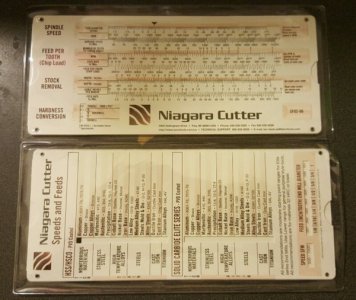It's a carbide.
And thanks for the tables.
Of course I know how to google, but there are soooo I many references out there. I, myself, have references I like regarding other things that I suggest to people because I trust and like the reference. So, I assume other people have the same. So, I ask...
Some the reasons the data is not consistent from chart to chart is determined by the size and type of machine tool, rigidity of the machine tool, rigidity of your setup, spindle horsepower, type of cutter, cutter material, coating, number of flutes, and so on, and so on. For example, Company A may suggest running their 1" diameter 5 flute TAIN coated end mill at 3600 rpm and .006" per tooth feed rate. That may work just fine on a Haas machining center with a 30 HP spindle but it doesn't work on a small bench top mill. I'm pointing this out not to be a smart a** but to point out that the charts don't always apply to our machines. They are a starting point.
My intent is not to offend anyone. My apologies in advance if I did.
Tom S.

